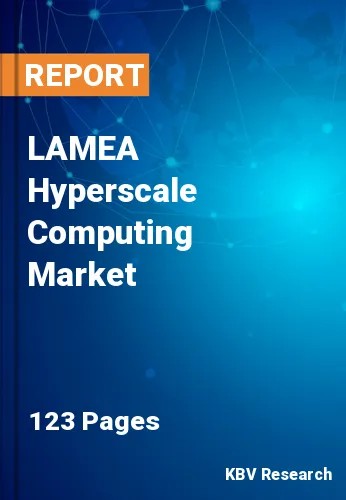The Latin America, Middle East and Africa Hyperscale Computing Market would witness market growth of 23.5% CAGR during the forecast period (2022-2028).
Hyperscale computing can support the growing demand for internet-facing and back-end computer resources without requiring more electricity, space, or cooling. In addition, IT experts can expand resources on-demand with the help of hyperscale architecture, making it simple to reconfigure software or hardware per an organization's needs and permitting structured component upgrades. Throughout the forecast period, the rising use of machine learning (ML), artificial intelligence (AI), industrial 4.0, autonomous vehicles, big data, the internet of things (IoT), and cloud computing is anticipated to significantly boost the hyperscale computing market's revenue growth.
The quick developments in AI, cloud computing, and IoT drive the rise of the hyper scaling cloud as a service trend. Demand for hyperscale data centers is quickly rising in response to the rising demand for infrastructure for cloud computing and IoT capabilities. Participants in the IT business now have the chance to move to hyperscale data centers for better data storage and management as well as to accrue bigger profits, security, and dependability. This is due to the growing demand for more effective high-speed data transport.
The Saudi Arabian government is putting regulations and programs into place to help educators deliver top-notch instruction while the country's educational system is constantly growing. The government has incorporated technology and statistical data into education to increase the stature of its academic institutions. In order to show its dedication to the mission, the government has improved internet connection in urban and rural areas. Various online learning platforms have been created to meet the demands of various pupils. Several institutions are looking for solutions to every issue the traditional educational system has caused as educational technology develops. Therefore, the hyperscale computing market in the LAMEA region will grow over the next few years.
The Brazil market dominated the LAMEA Hyperscale Computing Market by Country in 2021, and would continue to be a dominant market till 2028; thereby, achieving a market value of $3,365.4 million by 2028. The Argentina market is experiencing a CAGR of 24.2% during (2022 - 2028). Additionally, The UAE market would display a CAGR of 23.2% during (2022 - 2028).
Based on Application, the market is segmented into Cloud Computing, Big Data, IoT and Others. Based on Enterprise Size, the market is segmented into Large Enterprises and Small & Medium Enterprises. Based on Component the market is segmented into Solution and Service. Based on End-Use, the market is segmented into IT & Telecom, Retail & E-commerce, Media & Entertainment, Healthcare, BFSI and Others. Based on countries, the market is segmented into Brazil, Argentina, UAE, Saudi Arabia, South Africa, Nigeria, and Rest of LAMEA.
Free Valuable Insights: The Worldwide Hyperscale Computing Market is Projected to reach USD 177.2 Billion by 2028, at a CAGR of 21.4%
The market research report covers the analysis of key stake holders of the market. Key companies profiled in the report include Amazon Web Services, Inc. (Amazon.com, Inc.), Hewlett Packard Enterprise Company (HP Development Company L.P.), Intel Corporation, Microsoft Corporation, Google LLC (Alphabet, Inc.), Oracle Corporation, Dell Technologies, Inc., Alibaba Cloud (Alibaba Group Holding Limited), Viavi Solutions, Inc., and Server Technology, Inc. (Legrand Group).
By Application
By Enterprise Size
By Component
By End-Use
By Country
Our team of dedicated experts can provide you with attractive expansion opportunities for your business.

